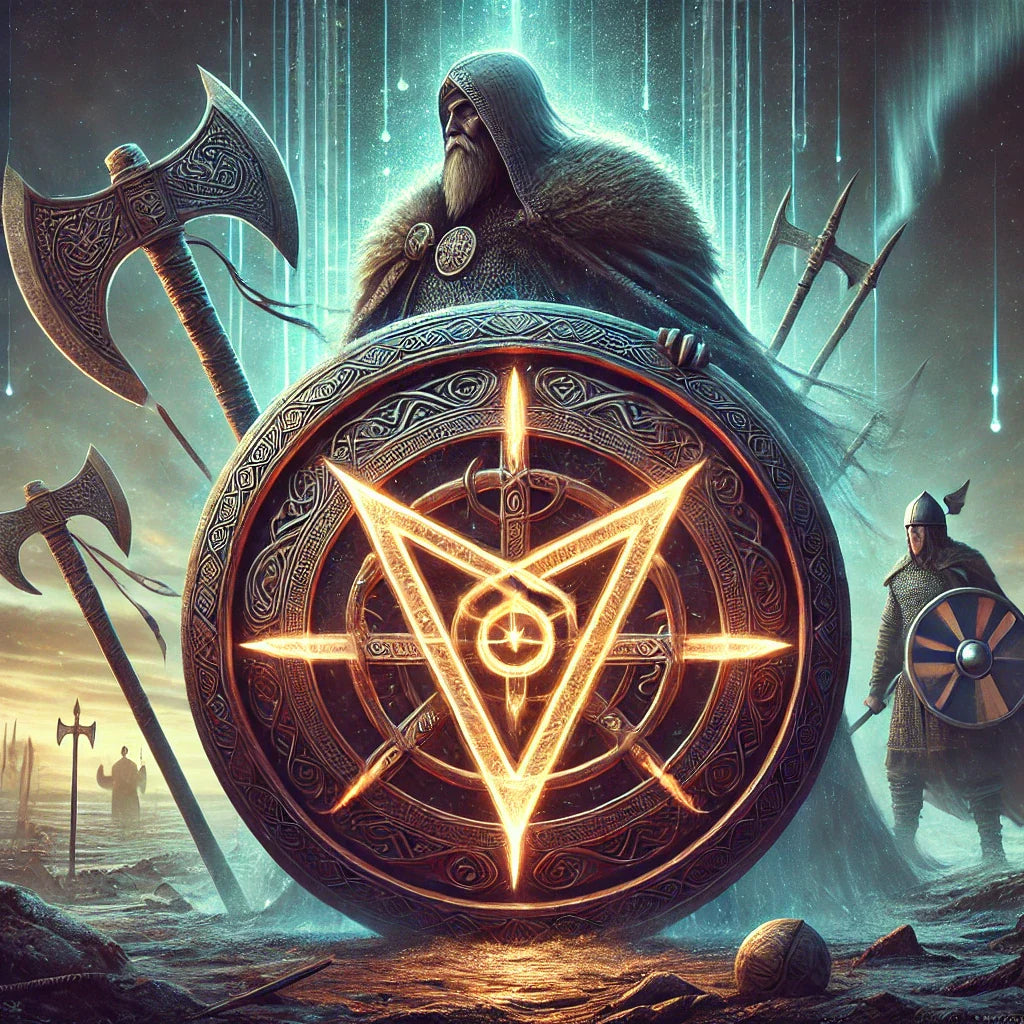How the Helm of Awe is Still a Powerful Symbol Today

How the Helm of Awe is Still a Powerful Symbol Today
The Vikings may have lived over a thousand years ago, but many of their traditions, beliefs, and symbols still carry deep meaning today. Among these, the Helm of Awe, or Ægishjálmur, stands out as one of the most recognizable and powerful Norse symbols. Originally believed to provide protection, strength, and fearlessness, it was commonly used by Viking warriors who painted or carved it onto their foreheads, shields, and armor before heading into battle. But while the Viking Age has long passed, the Helm of Awe remains a widely used and respected symbol in modern times, appearing in tattoos, jewelry, and artwork as a representation of inner strength, resilience, and the ability to overcome life's challenges. Many people today wear the Helm of Awe, not because they are warriors preparing for battle, but because they see it as a reminder to stay strong in the face of adversity, to protect themselves from negativity, and to carry the Viking spirit of courage into their daily lives. But why has this ancient Norse symbol remained relevant for so long? What is it about the Helm of Awe that continues to inspire people today? How has its meaning evolved beyond its origins as a battle charm into something even more significant? Let’s take a deeper look at how this legendary Viking emblem has stood the test of time and why it is still considered a symbol of power and protection.
The Helm of Awe: A Symbol of Strength and Protection
For the Vikings, symbols were more than just designs—they were sources of real power. The Helm of Awe was thought to be one of the strongest protective symbols, forming an invisible shield around the wearer, both physically and spiritually. Unlike a traditional metal helmet that protected the head, the Helm of Awe was a magical force that surrounded the entire body, offering both physical invincibility and mental fortitude. Viking warriors would paint or carve this symbol onto their foreheads, shields, and armor, believing it would make them fearless and untouchable in battle. But the Helm of Awe wasn’t just about defense; it was also meant to strike terror into enemies, making them hesitate, lose confidence, or even flee before a fight began.
The design of the symbol itself was significant. It features eight arms radiating from a central point, similar to a spiked wheel or sunburst. This was not a random artistic choice—the eight arms were believed to channel energy outward, forming a barrier of protection around the person who bore the symbol. The Vikings believed in the power of runes, magic, and divine symbols, and the Helm of Awe was thought to be created through these mystical forces. The name itself gives us insight into its purpose. "Ægir" means awe or terror in Old Norse, while "hjálmur" means helm or helmet. Together, the words describe something that was meant to inspire fear in enemies while shielding the warrior from harm. This combination of protection and intimidation made the Helm of Awe one of the most widely respected Viking symbols, not just in battle, but in other aspects of life as well. This idea of symbols providing both strength and protection is also seen in other Norse emblems, such as the Tree of Life, a sacred Viking symbol representing balance, wisdom, and the deep connection between all living things. If you're interested in learning more about Norse mythology and its symbols, check out our article on Tree of Life Necklace Meaning and Significance.
From the Viking Age to Modern Times
Although the Helm of Awe was originally used by Viking warriors to gain protection in battle, its significance has expanded over time. Today, people who wear this symbol do not do so because they are preparing for war, but because they see it as a reminder of their own strength and ability to face challenges. Just as Vikings believed in the power of symbols to guide and protect them, modern individuals use the Helm of Awe to represent resilience, self-confidence, and mental toughness. Many people have this symbol tattooed on their bodies as a way to carry its energy with them at all times, while others wear it on rings, necklaces, and bracelets to serve as a constant reminder to stay strong and fearless.
In today's world, challenges may not come in the form of swords and shields, but they still require mental strength and courage. Whether it’s dealing with personal struggles, overcoming obstacles in one’s career, or pushing through difficult times, the Helm of Awe remains a symbol of resilience. The same energy that gave Viking warriors the confidence to stand tall in the face of danger can be applied to anyone who seeks inner strength in the modern world. This is why the Helm of Awe continues to be a widely used symbol, especially for those who feel connected to Norse culture, Viking heritage, or the warrior mindset. Similar to how Vikings wore runes and symbols for guidance and protection, many people today wear Helm of Awe jewelry as a way to carry this ancient power with them. If you’re interested in incorporating this legendary symbol into your life, explore our Helm of Awe Viking Jewelry Collection.
The Helm of Awe as a Symbol of Personal Growth
Beyond its use in battle, the Helm of Awe has come to represent something much deeper—it is a symbol of personal empowerment. While the Vikings may have used it to strike fear into their enemies, today it serves as a reminder of inner strength, self-belief, and overcoming fear. The Helm of Awe encourages people to push past self-doubt, take control of their lives, and remain strong in the face of adversity. It is no longer just about protection from physical harm, but also protection from negativity, obstacles, and the limitations people place on themselves. Much like Viking rings and amulets, which carried sacred runes for strength and guidance, the Helm of Awe is used as a personal emblem of courage and resilience. If you want to learn more about Norse-inspired jewelry and its significance, check out our article on Top 5 Viking Rings and Their Norse Symbols.
Conclusion
The Helm of Awe has endured for centuries because its message is timeless. While it was once used by Viking warriors in battle, it has evolved into a symbol of personal strength, resilience, and protection that continues to inspire people today. Whether worn as a tattoo, jewelry, or simply kept as a personal emblem, the Helm of Awe serves as a reminder that true power comes from within. It represents the ability to face challenges with confidence, to overcome obstacles, and to carry the fearless Viking spirit into everyday life. The Vikings may be long gone, but their wisdom, their beliefs, and their symbols continue to shape the modern world. Whether you wear it for its historical significance, its spiritual meaning, or as a reminder to stay strong, the Helm of Awe remains a powerful emblem that continues to stand the test of time.




